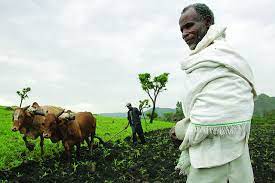Summary :
Because of the continued combustion of fossil fuels, the degradation of forest cover, and the usage of animal farming, our climate has deteriorated. As a result of the accumulation of greenhouse gases, all of these have contributed to global warming (GHG). Rising temperatures have resulted in variable weather and a seasonal cycle that is unpredictable.

Ethiopia Farmer
Ethiopia, a farming-dependent country, has borne the brunt of these consequences. They have, however, made initiatives to reduce the consequences of climate change and increase their agricultural output.
Findings of Study:
In a study led by Diana Feliciano of the University of Aberdeen in the United Kingdom, 25 Ethiopian smallholder farmers were questioned, according to Susan Chacko in a Down to Earth article. The Mitigation Options Tool (MOT) was used in the study to assess GHG emissions in farming and to note mitigation options in order to better appreciate the mutual benefits between farmers and the environment.
Farmers had seen changes in weather patterns, such as higher temperatures and less rain, as well as an increase in crop diseases, lower yields, crop season delays, and the disappearance of water springs. To mitigate the effects of climate change, small farmers began to utilize techniques such as reduced tillage and adding manure to the soil.
Smallholder farmers are farmers in developing nations who own and control a small plot of land on which they cultivate crops for both commercial and personal use. Small-scale farmers produce less yields with fewer resources than large-scale farms. Smallholders are frequently excluded from the formal economy due to a lack of government registration and adequate legal documentation, and they may miss out on government agricultural regulations and programmes.
Smallholder farmers may grow a little amount of crops, but they are the primary food producers in third-world countries, and their success, as indicated above, results in increased food production, a stronger economy, and a reduction in poverty.
Traditional inversion tillage with ploughs and harrows was used in Ethiopia, which degraded the quality of the soil’s organic matter over time. Reduced tillage practices cause less damage to a farm’s soil and are shallower.
Such practices allow the natural structure of the soil to be preserved, which helps to minimize soil erosion. Reduced tillage also cuts down on the use of machines and saves money on fuel and labour. The organic characteristics of the soil, as well as its carbon content, are conserved and revitalized, thanks to the addition of manure.
The following climate mitigation practices have increased soil water retention capacity, which is a boon for countries like Ethiopia, which are generally arid and receive very little rainfall. Increased water retention by the more nutrient-rich soils in Ethiopian small farms can lead to improved yields.
Crop rotation and planting new varieties of crops are further climate mitigation practices used by Ethiopian small farmers, which boost soil fertility, increase yields, and keep pests and diseases at bay, among other things.
Farmers are also introducing indigenous animal varieties and native Desho grass strips to their farming operations in modest numbers. They’re using boundary planting to replace wheat with barley, which thrives in shallow soil and requires less water. Smallholders have expanded their usage of fertilizers, are planting crops earlier, and are storing crops as a backup in case of low production years. They’ve also recently sought government assistance through agricultural officers and agents to help them better manage their farms
Ethiopian farmer

